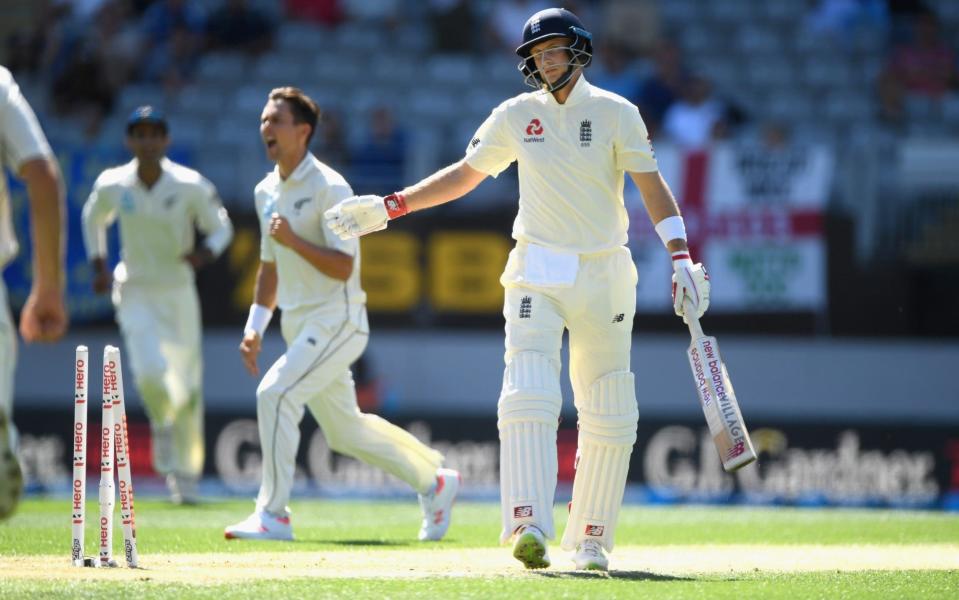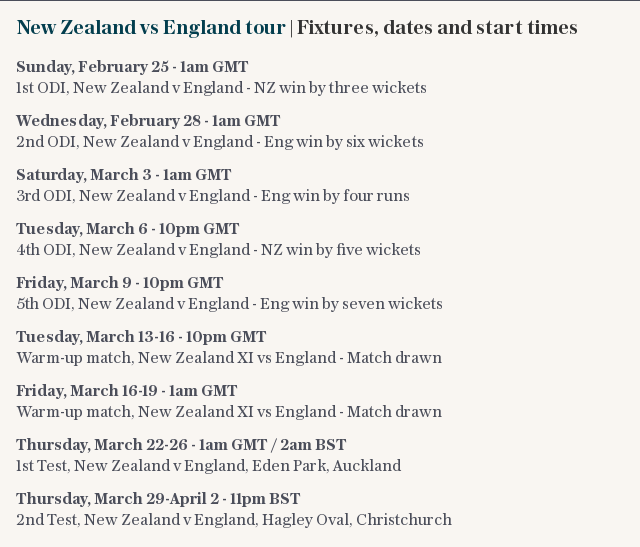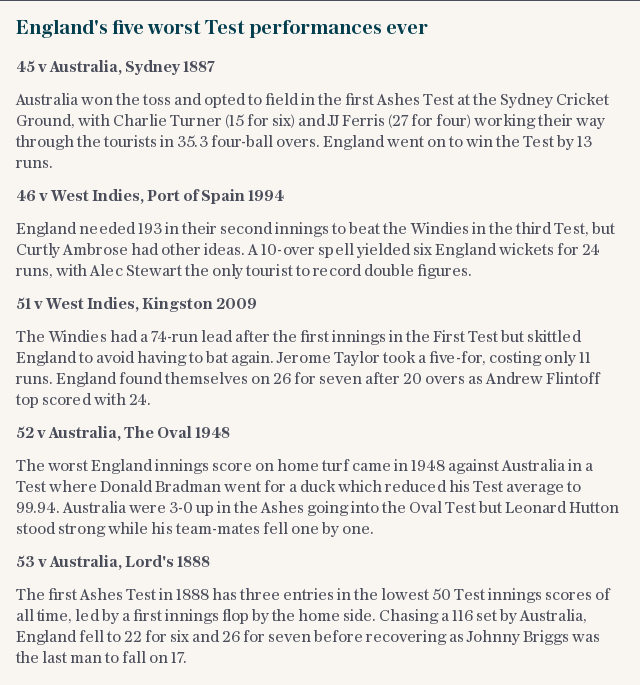Humiliation in New Zealand as England bowled out for 58 - their sixth lowest Test total ever

It was the most amazing session. Not since Stuart Broad took his eight for 15 against Australia in 2015 had England been involved in such low scoring. Yet England’s pitiful total of 58 was entirely explicable because they batted with flabbergasting feebleness and the naivety of schoolboys without a coach.
The pink ball swung all right in the first day/night Test in New Zealand, but it was nothing exceptional by the standards of swing bowling through the ages. What was wrong was England’s response, which left them with faces as pink as the ball with which Trent Boult reduced them to 27 for nine. England were one wicket away from the embarrassment of making the second lowest Test total of all time, before Craig Overton rallied England to their sixth lowest total.
READ MORE: England’s five worst Test scores EVER
READ MORE: The stats behind Broad’s 400-wicket England haul
READ MORE: Broad’s greatest days for England
Today’s batsmen have to switch between three different formats and three different balls, which their predecessors never did. Yet that makes it all the more essential they should use their brains and think on their feet. Beguiled perhaps by the continuous sunshine of a late-summer afternoon at Eden Park, England batted as if it was another limited-overs game against a white ball which could not move sideways. In summary, they did not play the conditions as carefully and cleverly as Kane Williamson was to do.
When the ball is swinging, the first lesson of orthodoxy is that the batsman should stand outside his crease to reduce the amount of swing, ie the number of degrees which the ball can deviate off the straight. England, instead of minimising this curve, batted inside their creases and thus allowed the ball to swing to the maximum extent. What were they and the coaching staff thinking?
Orthodoxy’s second lesson when the ball is swinging is for the batsman to wait until it is under his eyes, reduce his backlift, and not attempt big shots - all anathema to the white-ball hitter. Joe Root played a big drive to be bowled through the gate, Jonny Bairstow, trying another, was caught and bowled by Tim Southee, and Chris Woakes copied his captain’s example exactly.

Root had promoted himself to No 3, replacing James Vince so Overton could become fourth seamer, but in his keenness to lead, Root continued to try and run before he could walk, as in Australia. Maybe too much white-ball cricket is another contributory factor: at any rate Root’s immaculate forward defensive stroke was not to be seen.
As usual in such collapses there was not much playing and missing: the ball moved enough to take the edge rather than too much. Data from that Trent Bridge Test of 2015 demonstrated that the red ball then had swung twice as much as the pink ball here. When New Zealand batted, less than two hours after the start, the Kookaburra’s movement was not extravagant - and neither was New Zealand’s batting.

It is possible to be lulled by the friendliness of New Zealand in general, and their cricketers, and caught off guard. On a gloriously sunny afternoon of bright light England cannot have sensed any great threat when Williamson disarmingly invited them to bat. But New Zealand have learned to make the most of their scant resources, boxing clever to fight above their weight, and an example of their clever planning was not to provide any left-arm pace bowler for England to bat against in their four days of practice at Hamilton, then unleash two - Boult and Neil Wagner - at Eden Park; England, of course, have no left-armer of their own to bat against in nets. Thus Boult, with his angle as well as his swing, took England by considerable surprise.

Yet again, when preparing for a Test series, it has to be said there is no substitute for playing competitive first-class matches. But when would England have fitted those in on a tour which began in late October and extends into April? England could have cut out the T20 tri-series against Australia and New Zealand and played a couple of first-class matches here instead, but the ECB’s broadcasting deals would have been slashed.
Boult, at waspish pace, had figures of 7-3-9-5 before Overton took the long handle to him. England’s management had taken a shine to Overton when he was bowling with spirit in Australia, and now it saved England from taking the all-time booby prize. England were 23 for seven when Overton entered, and New Zealand’s total of 26 against England in 1954-5 still lay ahead. England’s lowest ever total of 45 in 1887-8 was also a long way off, yet Overton averted that embarrassment too by cover-driving Boult and pulling a short ball for six. He deserved better support than Stuart Broad and James Anderson briefly afforded him. Disappointed as England’s two senior bowlers may have been by the performance of their batsmen, that was no reason for them to bat even more loosely.

Boult was superb except for one tiny detail: he did not pitch his first four balls sufficiently full to drag Alastair Cook forwards. As soon as he did so, Cook edged to second slip. A similar delivery, shaping away from the lefthander on a fullish length, dismissed Malan, who had been promoted to four. In both cases they were trapped inside their creases instead of giving themselves their best chance of surviving by edging forwards. Boult and Southee would then have bounced them but they were bowling no faster than the mid-130s kph.

Stokes looked as though he had hardly played any cricket since his previous Test last September against West Indies at Lord’s: he was late on his shot in addition to thinking that a cross-seamer would swing, which it did not and hit his offstump. Stokes had put more into his bowling practice before the Test than most number fives do. Boult at that point had four wickets for seven.
Southee followed Boult through the breach before England were sufficiently alert to man the walls. Mark Stoneman, like his teammates, was caught in the crease, driving. Southee tricked Moeen Ali, playing his 50th Test, with an offcutter that turned into a very low full toss that Moeen played all around. If Southee’s return catch to dismiss Bairstow was sharp, Williamson’s catch was up there with the all-time grabs in the gully: the ball had flown past him by the time he had stuck up his left hand.

With all the inevitability of cricket, everything that had gone right for New Zealand went wrong for England. Liam Livingstone, subbing briefly for Stoneman at cover-point, cleverly anticipated a quick single at the start of New Zealand’s innings but missed with his throw. New Zealand had caught every chance, but as soon as Jeet Raval nicked one, Root dropped it at second slip and had to have the little finger of his right hand bandaged. Broad’s 400th wicket was postponed until the final session when Tom Latham clipped a catch to mid-wicket.
England wasted a review - Root again too keen, this time in believing Woakes - and
In England’s hands the pink ball behaved all too normally as Williamson batted all too sensibly. He only drove off the front foot if he could get to the pitch, then forced off the back foot when England pitched too short. England supporters in the crowd were mostly stunned into silence, New Zealand’s too polite to gloat, because this is cricket not the normal sport at Eden Park.

 Yahoo Sport
Yahoo Sport 





































